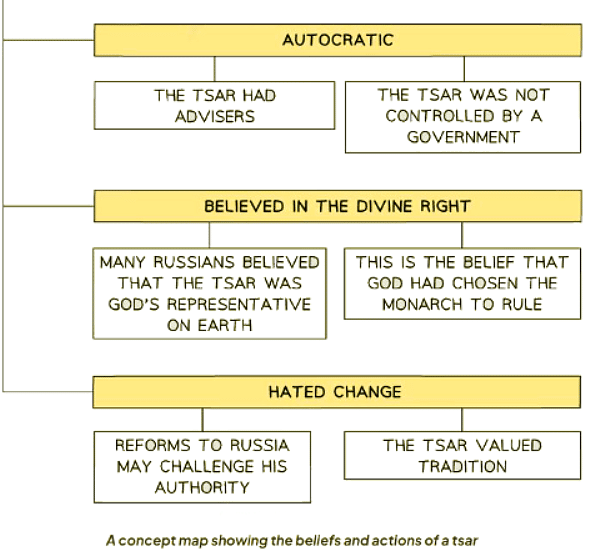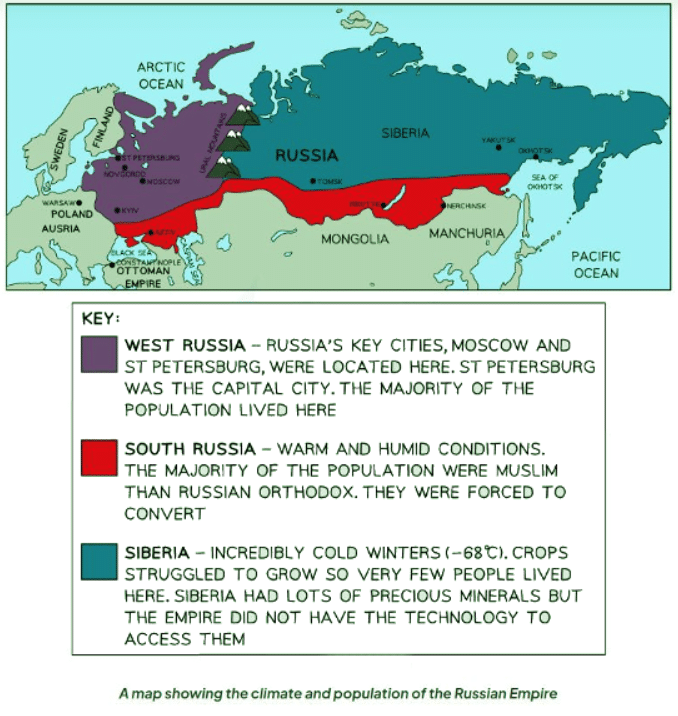Class 10 Exam > Class 10 Notes > History for GCSE/IGCSE > Tsarist Russia by 1905
Tsarist Russia by 1905 | History for GCSE/IGCSE - Class 10 PDF Download
| Table of contents |

|
| What was Russian Society Like in 1905? - Summary |

|
| What is a Tsar? |

|
| Industrialisation |

|
| The Geography of the Russian Empire |

|
| Social Backwardness |

|
What was Russian Society Like in 1905? - Summary
- Russia in 1905 was a unique country with a complex identity. For many centuries, the West feared Russia due to its size, ambition, and isolationism. Spanning both Asia and Europe, Russia did not fit neatly into either Asian or European culture, which influenced how Russians perceived Europe.
- Some Russians, known as Slavophiles, viewed Russia as a special nation in need of protection. They distrusted Europe, fearing it would alter Russia’s national identity. An example of Russia's distinctiveness was its use of the Julian Calendar in 1905, while many other countries had adopted the Gregorian calendar almost 300 years earlier. The Julian Calendar was 13 days behind the Gregorian calendar, symbolizing Russia’s desire to maintain its traditions.
- Other Russians, called Westernisers, sought inspiration from Europe and wanted to apply European ideas to Russia. A notable Westerniser was Tsar Peter the Great, who, in 1703, built the new capital city of St. Petersburg in a Parisian style, contrasting with the old capital, Moscow, which had a Slavic style.
- Russian society rested on three ‘pillars’: the tsar, the Orthodox Church, and the army. These institutions were crucial for Russia’s stability. However, by 1905, the people began to question and challenge these pillars.
What is a Tsar?
- Tsar is the Russian word for 'King'. A queen was called a tsarina.
- By 1905, a tsar or tsarina had ruled Russia for nearly 300 years. The Romanov dynasty established control over Russia in 1613.
- Tsars had many specific characteristics.


Industrialisation
- For many nations, industrial revolutions emerged during the 18th century.
- By the year 1905, Britain boasted advancements like railways, motorized tractors, and iron warships.
- Germany stood out as the global leader in steel production, surpassing Britain as early as 1893.
- Russia lagged behind in experiencing a significant industrial revolution.
- Russia's industrial growth primarily occurred in the western regions of the empire.
- Russian laborers struggled to match the skill levels of their Western European counterparts.
- Russia focused on producing pig iron, contrasting with Britain and Germany's emphasis on alloy production like steel.
- Infrastructure challenges persisted in Russia, particularly the lack of widespread road networks.
- Despite obstacles, Russia began building its railway system and had over 30,000 miles of tracks in place.
The Geography of the Russian Empire
- The Russian Empire covered a vast area, stretching almost 5,000 kilometers wide, extending across both Europe and Asia. There were notable disparities in living standards throughout the empire.
Social Backwardness
- Historical Description of Russia in 1905:
- Most of the Russian population resided in villages or mirs.
- By 1905, approximately 87% of the Russian population lived in rural areas.
- The Russian Empire had a limited number of urban centers.
- Peasant Farmers and Land Issues:
- Peasant farmers predominantly engaged in agriculture using traditional tools and methods.
- Despite being freed by the Emancipation Edict in 1861, many peasants still faced restrictions on their freedoms and rights by 1905.
- Land allocation problems arose as land was typically passed down through generations by inheritance.
- Family plots of land had become fragmented or too small by 1905, hindering efficient farming practices.
- Lack of modern agricultural techniques and equipment further impeded farming productivity.
- Uninherited land parcels remained unused, contributing to inefficiencies.
- Education and Literacy:
- More than 60% of Russia's population was illiterate, posing a significant educational challenge.
- In contrast, only 3% of Britain's population faced similar literacy issues.
- Role of the Russian Orthodox Church:
- Due to Russia's vast size, citizens primarily received information on key policies from their local Russian Orthodox Church.
- The Tsar's laws were disseminated by officials and communicated to the public through priests in churches.
- The Church emphasized obedience to the Tsar as God's representative on Earth, playing a crucial role in law enforcement.
Question for Tsarist Russia by 1905Try yourself: What were the two main perspectives in Russian society in 1905?View Solution
The document Tsarist Russia by 1905 | History for GCSE/IGCSE - Class 10 is a part of the Class 10 Course History for GCSE/IGCSE.
All you need of Class 10 at this link: Class 10
|
79 videos|87 docs|18 tests
|
FAQs on Tsarist Russia by 1905 - History for GCSE/IGCSE - Class 10
| 1. What was the social structure of Russian society in 1905? |  |
Ans. Russian society in 1905 was highly stratified, with a small elite class of nobles and wealthy landowners at the top, followed by a large population of peasants and urban workers.
| 2. Who was the Tsar in 1905 and what role did he play in Russian society? |  |
Ans. The Tsar in 1905 was Nicholas II, who held absolute power over Russia. As the autocratic ruler, he controlled all aspects of Russian society and was seen as a father figure by his subjects.
| 3. How did industrialization impact Russian society in 1905? |  |
Ans. Industrialization in Russia led to the growth of urban centers and the emergence of a working class. This shift from an agrarian to an industrial economy brought about social change and new challenges for the Russian people.
| 4. What was the geography of the Russian Empire like in 1905? |  |
Ans. The Russian Empire in 1905 was vast, spanning across Europe and Asia. It encompassed diverse landscapes, climates, and cultures, making it a complex and challenging empire to govern.
| 5. How did social backwardness contribute to the unrest in Tsarist Russia in 1905? |  |
Ans. Social backwardness, including widespread poverty, illiteracy, and inequality, fueled discontent among the Russian population. This dissatisfaction with the Tsarist regime ultimately led to the 1905 Revolution.
Related Searches





















